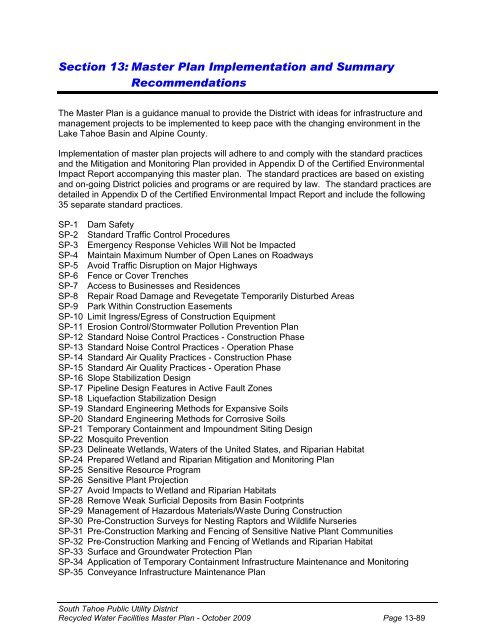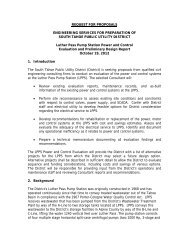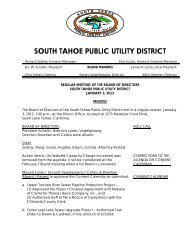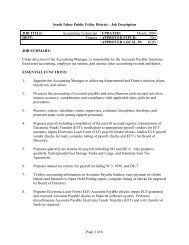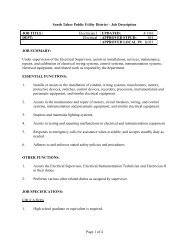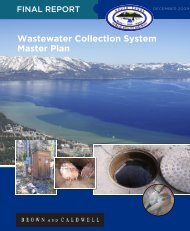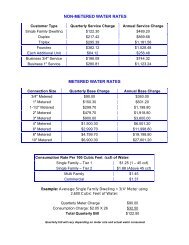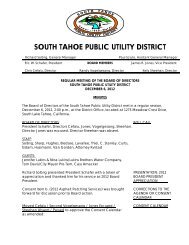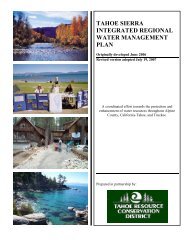October 2009 - South Tahoe Public Utility District
October 2009 - South Tahoe Public Utility District
October 2009 - South Tahoe Public Utility District
Create successful ePaper yourself
Turn your PDF publications into a flip-book with our unique Google optimized e-Paper software.
Section 13: Master Plan Implementation and Summary<br />
Recommendations<br />
The Master Plan is a guidance manual to provide the <strong>District</strong> with ideas for infrastructure and<br />
management projects to be implemented to keep pace with the changing environment in the<br />
Lake <strong>Tahoe</strong> Basin and Alpine County.<br />
Implementation of master plan projects will adhere to and comply with the standard practices<br />
and the Mitigation and Monitoring Plan provided in Appendix D of the Certified Environmental<br />
Impact Report accompanying this master plan. The standard practices are based on existing<br />
and on-going <strong>District</strong> policies and programs or are required by law. The standard practices are<br />
detailed in Appendix D of the Certified Environmental Impact Report and include the following<br />
35 separate standard practices.<br />
SP-1 Dam Safety<br />
SP-2 Standard Traffic Control Procedures<br />
SP-3 Emergency Response Vehicles Will Not be Impacted<br />
SP-4 Maintain Maximum Number of Open Lanes on Roadways<br />
SP-5 Avoid Traffic Disruption on Major Highways<br />
SP-6 Fence or Cover Trenches<br />
SP-7 Access to Businesses and Residences<br />
SP-8 Repair Road Damage and Revegetate Temporarily Disturbed Areas<br />
SP-9 Park Within Construction Easements<br />
SP-10 Limit Ingress/Egress of Construction Equipment<br />
SP-11 Erosion Control/Stormwater Pollution Prevention Plan<br />
SP-12 Standard Noise Control Practices - Construction Phase<br />
SP-13 Standard Noise Control Practices - Operation Phase<br />
SP-14 Standard Air Quality Practices - Construction Phase<br />
SP-15 Standard Air Quality Practices - Operation Phase<br />
SP-16 Slope Stabilization Design<br />
SP-17 Pipeline Design Features in Active Fault Zones<br />
SP-18 Liquefaction Stabilization Design<br />
SP-19 Standard Engineering Methods for Expansive Soils<br />
SP-20 Standard Engineering Methods for Corrosive Soils<br />
SP-21 Temporary Containment and Impoundment Siting Design<br />
SP-22 Mosquito Prevention<br />
SP-23 Delineate Wetlands, Waters of the United States, and Riparian Habitat<br />
SP-24 Prepared Wetland and Riparian Mitigation and Monitoring Plan<br />
SP-25 Sensitive Resource Program<br />
SP-26 Sensitive Plant Projection<br />
SP-27 Avoid Impacts to Wetland and Riparian Habitats<br />
SP-28 Remove Weak Surficial Deposits from Basin Footprints<br />
SP-29 Management of Hazardous Materials/Waste During Construction<br />
SP-30 Pre-Construction Surveys for Nesting Raptors and Wildlife Nurseries<br />
SP-31 Pre-Construction Marking and Fencing of Sensitive Native Plant Communities<br />
SP-32 Pre-Construction Marking and Fencing of Wetlands and Riparian Habitat<br />
SP-33 Surface and Groundwater Protection Plan<br />
SP-34 Application of Temporary Containment Infrastructure Maintenance and Monitoring<br />
SP-35 Conveyance Infrastructure Maintenance Plan<br />
<strong>South</strong> <strong>Tahoe</strong> <strong>Public</strong> <strong>Utility</strong> <strong>District</strong><br />
Recycled Water Facilities Master Plan - <strong>October</strong> <strong>2009</strong> Page 13-89


